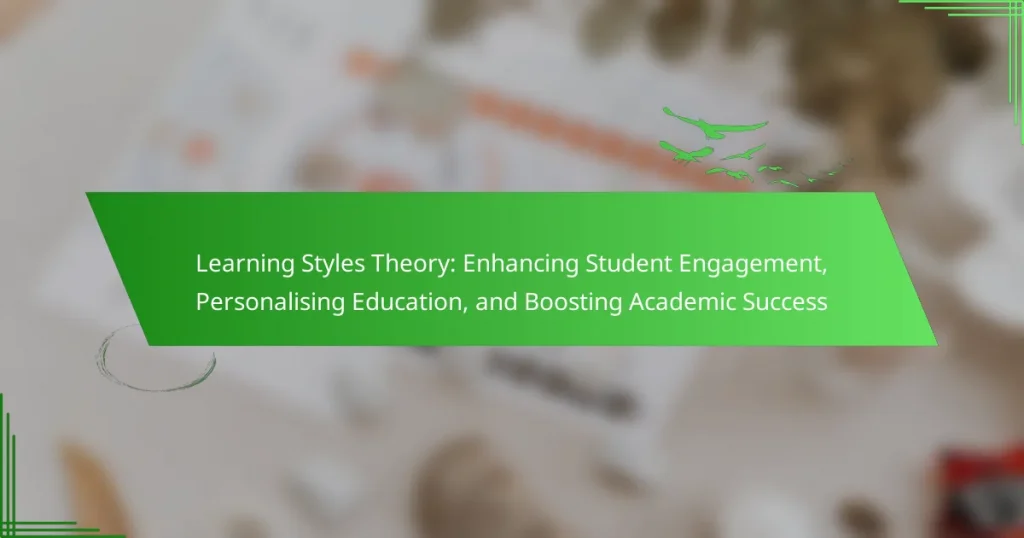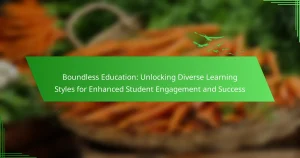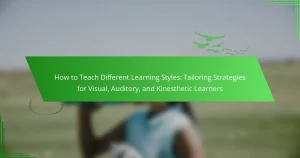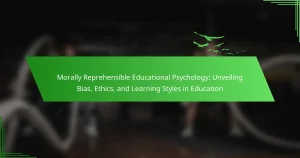Learning Styles Theory enhances student engagement by personalizing education to meet diverse needs. This article explores key learning styles, the universal and unique attributes that influence learning, effective assessment strategies, and common challenges in implementation. It also discusses how tailored instructional methods can boost academic success and foster a supportive learning environment.
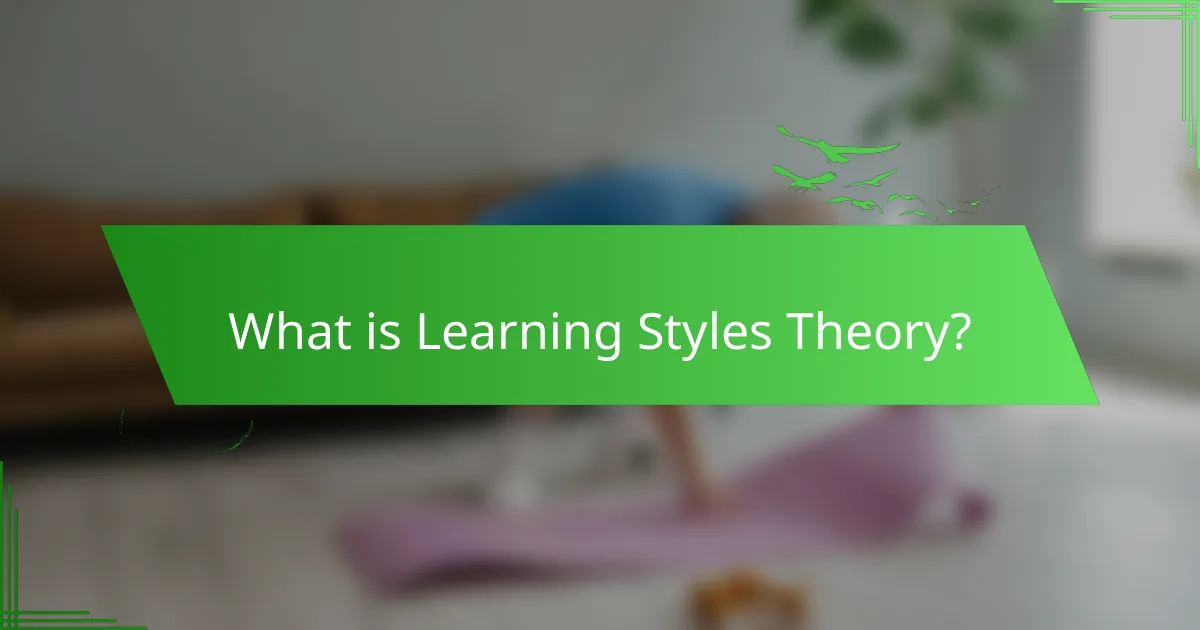
What is Learning Styles Theory?
Learning Styles Theory posits that individuals learn best when instruction aligns with their preferred learning style. This theory enhances student engagement by personalizing education to meet diverse needs, ultimately boosting academic success. Key learning styles include visual, auditory, and kinesthetic, each offering unique benefits. Research indicates that tailoring teaching methods to these styles can improve retention and understanding, fostering a more effective learning environment.
How did Learning Styles Theory originate?
Learning Styles Theory originated in the 1970s, primarily through the work of educational psychologist Howard Gardner. He introduced the concept of multiple intelligences, suggesting that individuals learn in different ways. This idea prompted further exploration into personalized education strategies, emphasizing the importance of adapting teaching methods to enhance student engagement and academic success. Research has since shown that recognizing diverse learning styles can significantly improve educational outcomes.
What are the key principles of Learning Styles Theory?
Learning Styles Theory emphasizes that individuals learn best through tailored approaches. Key principles include recognizing diverse learning preferences, such as visual, auditory, and kinesthetic styles. This personalization enhances student engagement, allowing educators to adapt their teaching methods effectively. Research indicates that aligning instruction with a student’s preferred learning style can significantly boost academic success. Additionally, fostering an inclusive environment that acknowledges these differences promotes a more effective learning experience for all students.

What are the universal attributes of Learning Styles?
The universal attributes of Learning Styles include individual preferences, cognitive processing, sensory modalities, and engagement strategies. These attributes help tailor educational approaches to enhance student involvement and facilitate better learning outcomes. Understanding these elements allows educators to personalize instruction, improving academic success.
How does Learning Styles Theory enhance student engagement?
Learning Styles Theory enhances student engagement by tailoring educational approaches to individual preferences. This personalization increases motivation and participation in learning activities. Research indicates that when instruction aligns with a student’s preferred learning style, academic performance improves significantly. For instance, visual learners benefit from diagrams, while kinesthetic learners thrive in hands-on activities. Ultimately, recognizing and applying Learning Styles Theory fosters a more inclusive and effective educational environment.
What role does personalization play in effective education?
Personalization significantly enhances education by tailoring learning experiences to individual student needs. This approach increases engagement, as students are more likely to connect with material that resonates with their unique learning styles. Research indicates that personalized education can lead to improved academic success, with students showing higher retention rates and motivation. By focusing on root attributes like adaptability and responsiveness, educators can create an environment that fosters deeper understanding and skill development.
How does Learning Styles Theory contribute to academic success?
Learning Styles Theory can significantly enhance academic success by personalizing education to meet individual needs. It fosters student engagement by aligning teaching methods with preferred learning styles, such as visual, auditory, or kinesthetic. This tailored approach can lead to improved retention and understanding of material. Research suggests that when students learn in ways that resonate with them, their motivation and performance increase, resulting in higher academic achievement. Furthermore, recognizing diverse learning styles promotes inclusivity, ensuring that all students have the opportunity to excel.
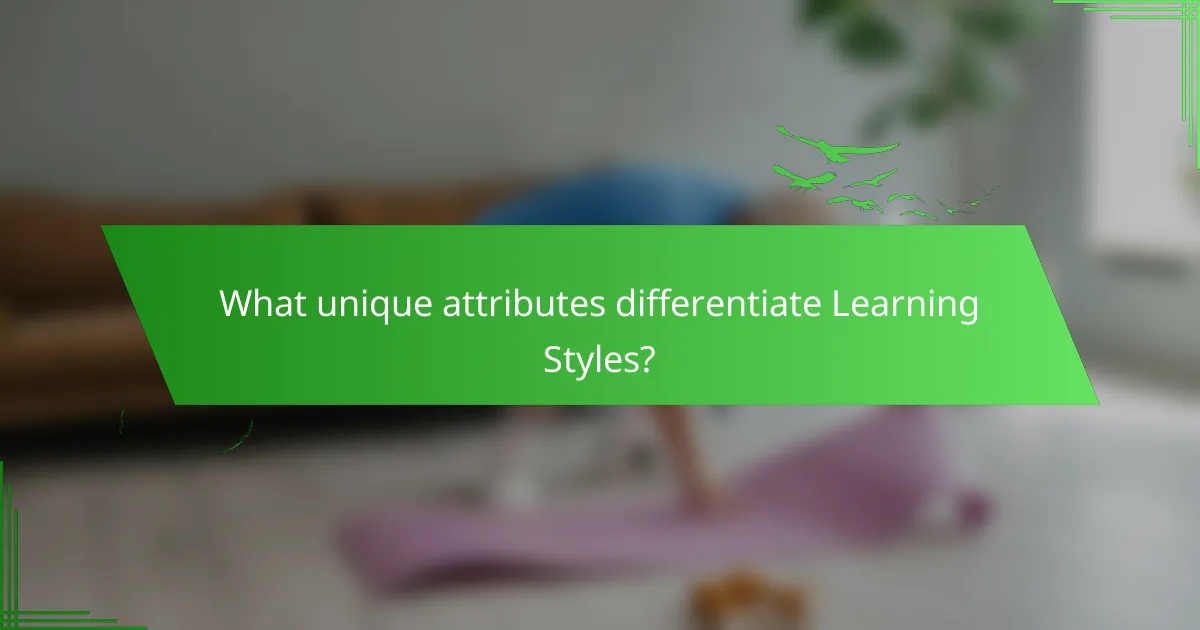
What unique attributes differentiate Learning Styles?
Learning styles are differentiated by unique attributes such as sensory modalities, learning preferences, and cognitive processes. Sensory modalities include visual, auditory, and kinesthetic styles, each engaging different senses for information absorption. Learning preferences reflect individual tendencies toward specific methods, such as collaborative or independent learning. Cognitive processes encompass how learners process information, including analytical versus holistic approaches. These unique attributes enhance student engagement and tailor educational experiences for improved academic success.
How do different learning styles impact teaching methods?
Different learning styles significantly influence teaching methods by necessitating personalized approaches. For instance, visual learners benefit from diagrams and videos, while auditory learners thrive with discussions and lectures. Kinesthetic learners engage more effectively through hands-on activities. Adapting teaching strategies to these styles enhances student engagement and boosts academic success. Research indicates that tailoring methods to learning preferences can improve retention rates by up to 30%. Understanding these dynamics allows educators to create more effective and inclusive learning environments.
What are the implications of adapting to individual learning styles?
Adapting to individual learning styles enhances engagement and boosts academic success. Personalized education meets diverse needs, fostering motivation and retention. Research indicates that students perform better when teaching aligns with their preferred learning modalities, such as visual, auditory, or kinesthetic approaches. This tailoring of instruction not only improves understanding but also cultivates a positive learning environment.

What rare attributes are associated with Learning Styles?
Learning styles exhibit rare attributes that enhance personalized education. One rare attribute is the impact of cultural background on learning preferences. This influences how students engage with material, affecting their motivation and retention. Another rare attribute is the integration of emotional intelligence, which shapes how learners process information. Additionally, the adaptability of learning styles in digital environments showcases their evolution in response to technology. Understanding these rare attributes can lead to more effective teaching strategies tailored to individual needs.
How can Learning Styles influence emotional intelligence in education?
Learning styles significantly influence emotional intelligence in education by enhancing student engagement and personalizing learning experiences. Different learning styles, such as visual, auditory, and kinesthetic, cater to individual preferences, fostering a supportive environment. This personalization increases empathy and self-awareness, key components of emotional intelligence. For example, students who engage in collaborative activities learn to navigate emotions and social dynamics effectively. Research indicates that tailored educational approaches can lead to improved emotional regulation and interpersonal skills, ultimately boosting academic success.
What innovative approaches exist for implementing Learning Styles in the classroom?
Innovative approaches for implementing Learning Styles in the classroom include differentiated instruction, technology integration, and experiential learning. Differentiated instruction tailors teaching methods to individual learning preferences, enhancing engagement. Technology integration utilizes tools like interactive software to cater to various styles, fostering personalized education. Experiential learning emphasizes hands-on experiences, allowing students to connect concepts to real-world applications, boosting academic success.
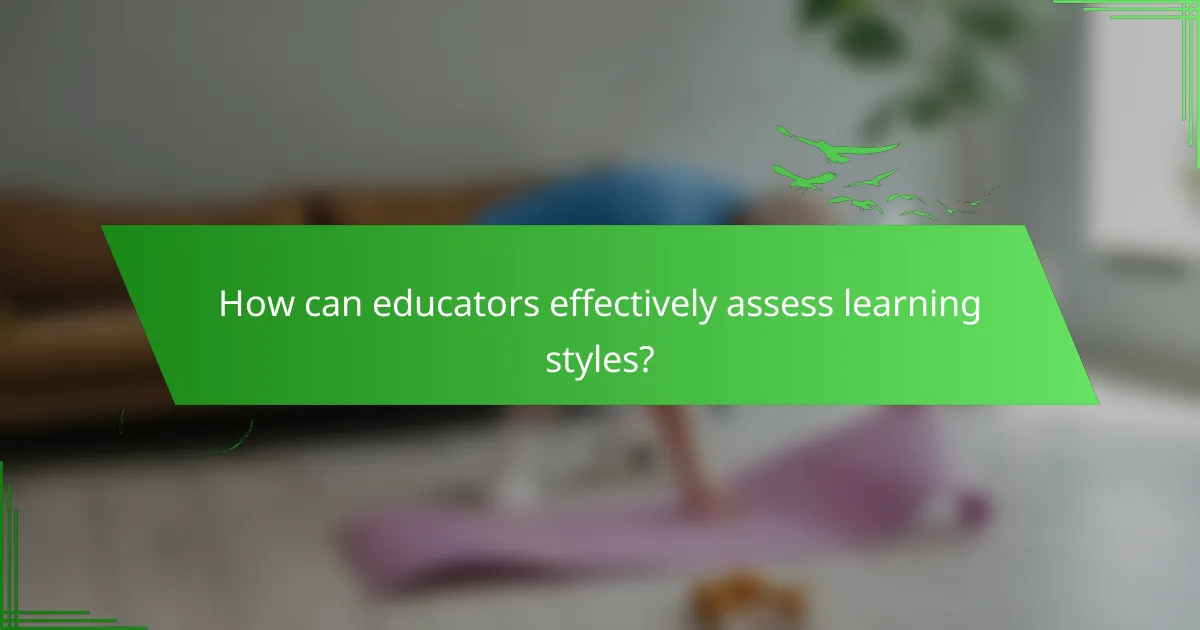
How can educators effectively assess learning styles?
Educators can effectively assess learning styles by employing diverse assessment strategies tailored to individual preferences. Utilizing surveys, observations, and interactive activities helps identify how students best absorb information.
Surveys like the VARK questionnaire reveal preferences for visual, auditory, reading/writing, or kinesthetic learning. Observations during class activities can highlight engagement levels and preferred methods of interaction. Interactive activities, such as group projects or hands-on experiments, allow educators to assess how students apply their learning styles in practice.
By combining these methods, educators can create a comprehensive profile for each student, enhancing engagement and personalizing educational approaches. This tailored strategy ultimately boosts academic success by aligning teaching methods with students’ unique attributes.
What tools and resources are available for identifying learning styles?
Various tools and resources can help identify learning styles effectively. Assessments like the VARK questionnaire and Gardner’s Multiple Intelligences test provide insights into individual preferences. Online platforms, such as Learning Styles Inventory, offer interactive methods for students to discover their styles. Educators can utilize these tools to tailor instruction, enhancing engagement and academic success. Additionally, workshops and seminars on learning styles can equip teachers with strategies to implement differentiated instruction in the classroom.
How can assessments be tailored to accommodate diverse learning preferences?
Assessments can be tailored to accommodate diverse learning preferences by incorporating varied formats and strategies. Utilizing visual, auditory, and kinesthetic elements enhances engagement. For example, offering multiple-choice questions alongside project-based assessments caters to different styles. Adaptive assessments can personalize the learning experience, ensuring all students can demonstrate their understanding effectively. Integrating technology, such as interactive quizzes and multimedia presentations, further supports diverse learning needs.
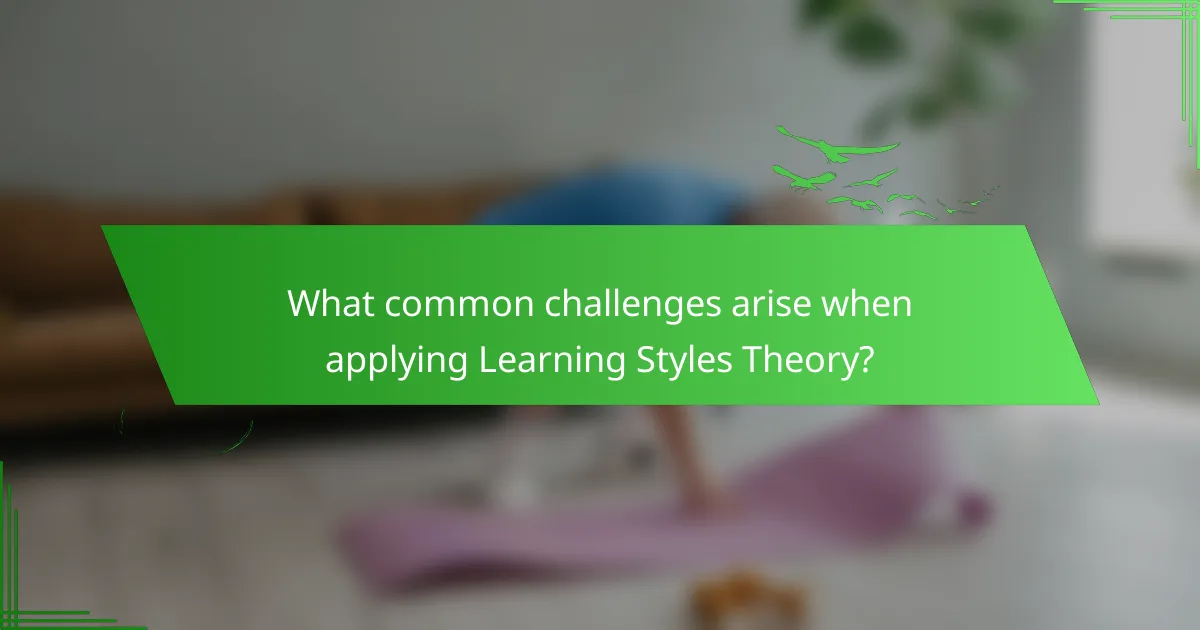
What common challenges arise when applying Learning Styles Theory?
Common challenges in applying Learning Styles Theory include oversimplification of student needs, lack of empirical support, and difficulties in implementation. Educators may struggle to tailor instruction effectively, leading to potential disengagement. Additionally, reliance on fixed learning styles can hinder adaptability in teaching methods, reducing overall academic success.
What misconceptions exist regarding Learning Styles Theory?
Many misconceptions exist regarding Learning Styles Theory, primarily the belief that teaching methods should strictly align with individual learning styles. Research indicates that there is insufficient evidence to support the idea that tailoring instruction to learning styles significantly enhances learning outcomes. Another misconception is that individuals possess a fixed learning style, while in reality, people often use a mix of styles depending on the context. Additionally, some educators mistakenly assume that identifying a student’s learning style will automatically improve engagement and academic success, overlooking other critical factors such as motivation and prior knowledge.
How can educators overcome resistance to implementing Learning Styles?
Educators can overcome resistance to implementing Learning Styles by providing evidence-based training, demonstrating its benefits, and fostering an open dialogue. Engaging faculty in workshops can highlight how personalized education enhances student engagement. Additionally, showcasing success stories from peers can alleviate skepticism. As a result, educators may be more willing to integrate Learning Styles into their teaching strategies.

What best practices should educators follow when applying Learning Styles?
Educators should adopt diverse strategies to effectively apply Learning Styles Theory. First, they must identify individual learning preferences through assessments. Next, they should tailor instructional methods to align with these preferences, enhancing engagement. Incorporating varied teaching materials, such as visual aids, hands-on activities, and discussions, caters to different styles. Regular feedback is essential to adjust approaches based on student responses. Lastly, fostering a supportive environment encourages students to explore and develop their preferred learning methods.
How can teachers create a learning environment that caters to various styles?
Teachers can create a learning environment that caters to various styles by incorporating diverse instructional strategies. Utilizing visual aids, hands-on activities, and auditory resources enhances engagement for different learners.
Recognizing the unique attributes of each learning style allows teachers to personalize education. For instance, kinesthetic learners thrive with interactive tasks, while visual learners benefit from diagrams and charts.
Implementing flexible group work fosters collaboration among students with varying strengths. This approach not only boosts academic success but also encourages peer learning.
Regular assessments can help identify students’ preferred learning styles, allowing for continuous adaptation of teaching methods. This responsiveness to individual needs enhances overall educational experiences.
What strategies can enhance the effectiveness of Learning Styles in education?
To enhance the effectiveness of Learning Styles in education, adopt diverse teaching strategies that cater to individual preferences. Incorporate multimedia resources, such as videos and interactive activities, to engage visual and kinesthetic learners. Personalized learning plans can address unique attributes of each student’s style, fostering deeper understanding and retention. Regular assessments and feedback loops ensure that teaching methods remain aligned with student needs, promoting academic success.
What are the common mistakes to avoid when using Learning Styles Theory?
Common mistakes to avoid when using Learning Styles Theory include overgeneralization, neglecting individual differences, and misapplying the theory in instructional design. Overgeneralization occurs when educators assume all students fit into one learning style, ignoring the unique attributes of each learner. Neglecting individual differences can lead to ineffective teaching strategies that do not engage all students. Misapplying the theory may result in rigid teaching approaches that limit flexibility and adaptability in the classroom.
What expert insights can guide the application of Learning Styles Theory?
Expert insights suggest that applying Learning Styles Theory can enhance student engagement through tailored teaching methods. Recognizing individual learning preferences allows educators to personalize education, fostering a more effective learning environment. Research indicates that students who engage with content aligned to their preferred learning style show improved academic success. Additionally, incorporating diverse instructional strategies can accommodate various learners, promoting inclusivity and maximizing overall educational outcomes.
